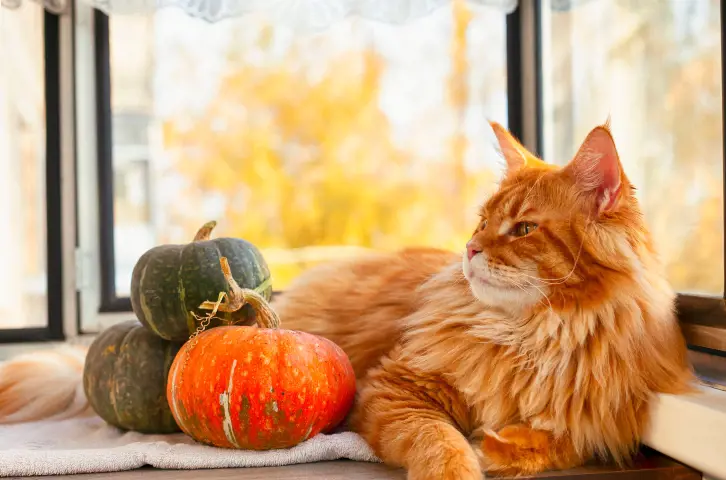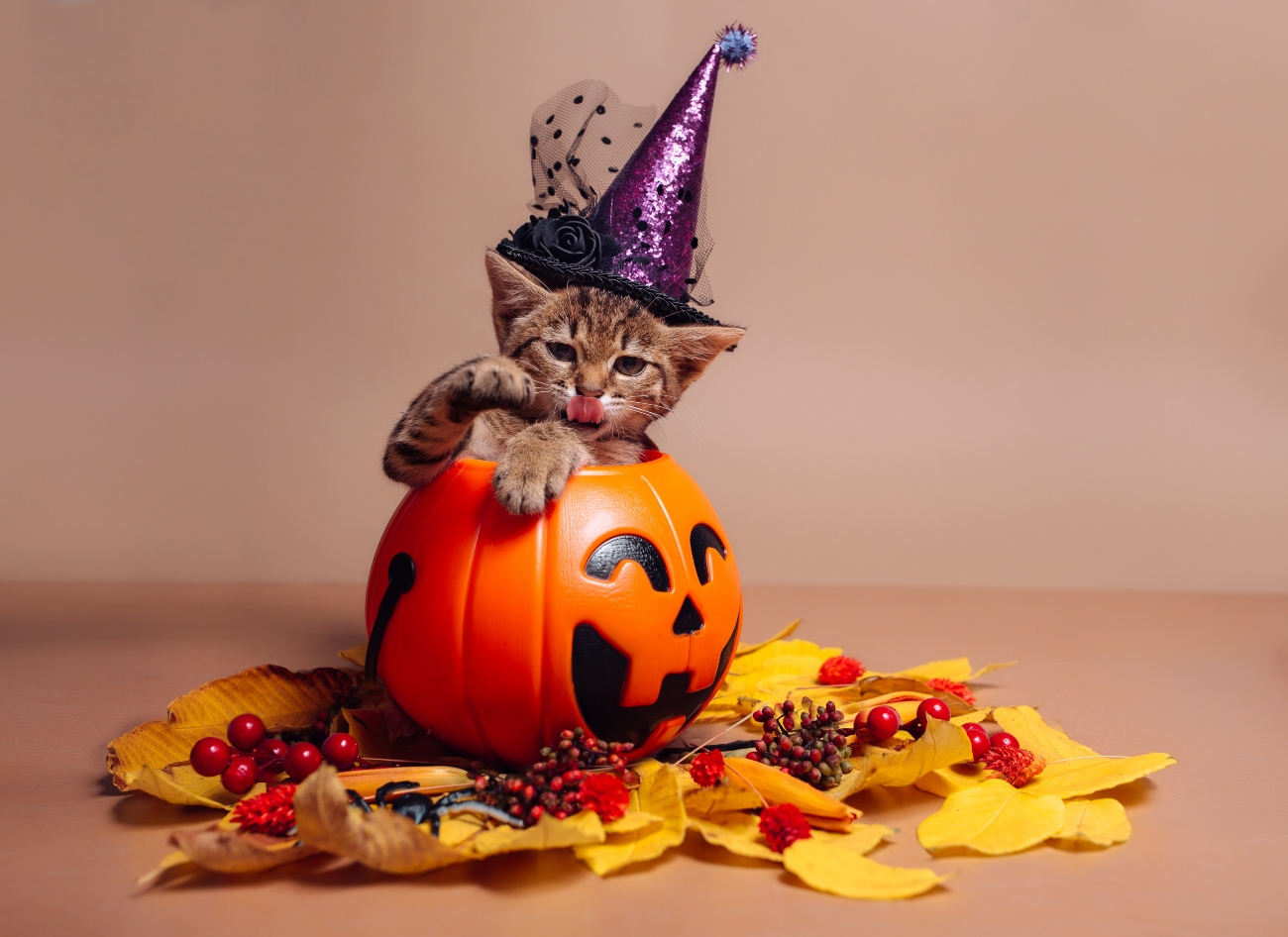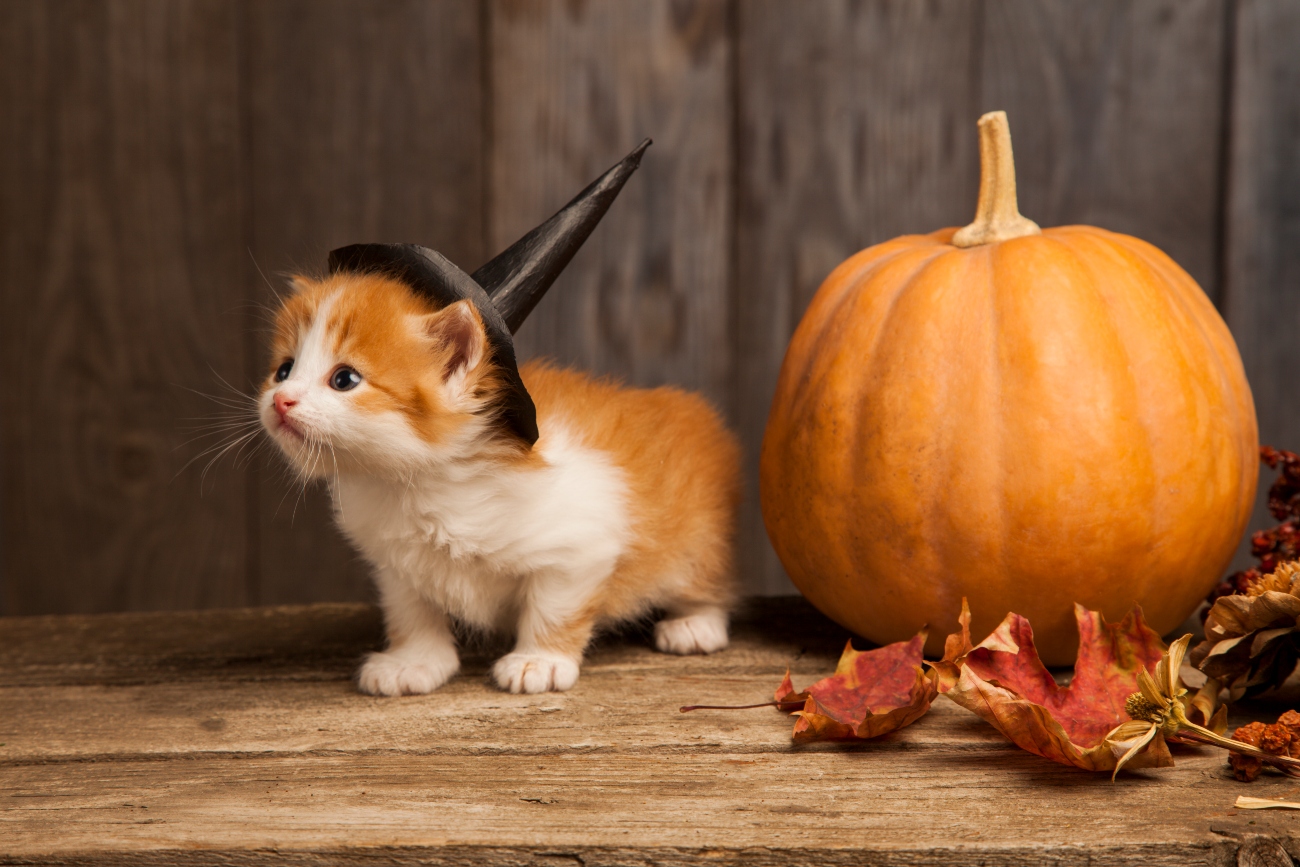Can cats eat pumpkin?
11th October, 2023

Will your cat get ill if it eats pumpkin? Get to know what benefits this healthy squash holds for your feline and which parts to feed them.
Bought some pumpkin for the festive season? Perhaps you’ve got some left over from Halloween? This fleshy, orange vegetable (although technically a fruit), is a favourite in households as part of many warming dishes – both savoury and sweet.
It might make a regular appearance on your dinnertime menu, but is it OK for your cat? Curious felines will lick just about anything that smells good, but not everything is good for their tummies.
Luckily, the delicious pumpkin is packed with goodness for your pet – as long as you feed it the right parts.
Learn what you should and shouldn’t put on their plate and why it’s always smart to protect them with specialist UK cat insurance.
We’ll also share a few other fruits and veg your feline can dig its teeth into and how to make sure they’re staying healthy.
So what are the benefits of pumpkins?
We’ve established that parts of this winter-warming veggie is OK for your pet, but just how good is it really? Pumpkins boast a wealth of advantages to your cat:
- This superfood is brimming with nutrients and vitamins A and C to keep your cat healthy and boost their immune system.
- The high fibre content may help your feline with constipation and diarrhoea.
- Low in calories and sodium, pumpkin can help with weight management.
Remember that cats are primarily carnivorous, so feeding them fruit and vegetables shouldn’t make up a huge part of their overall diet.
And, although you’ll be helping them get plenty of healthy vitamins and minerals, you’ll still need to protect them with UK cat insurance. Even the healthiest of felines can fall ill or get into unexpected scrapes.
How can pumpkin help constipation and diarrhoea in cats?
OK, it might seem odd that the same food can help with both of these issues but hear us out.
Pumpkin for constipation
You can tell your poor kitty is suffering from this uncomfortable digestive problem if they strain when going to the toilet, pass stools less than normal or if their faeces are small, hard and dry.
Pumpkins are rich in fibre and have a high water content, both of which can help soften stools and make it easier for your cat to go to the loo. Just add two to three teaspoons of pumpkin puree (homemade or tinned) to their regular wet food for mild constipation. If it still doesn’t help, give your vet a call.
Pumpkin for diarrhoea
This issue is easier to spot if your feline uses a litter box, as stools will be loose and wet. You might even notice the odd one elsewhere in your home!
If your cat uses the toilet outdoors, they may display other symptoms, like:
- Loss of appetite
- Nausea
- Vomiting
- Tiredness and weakness
- Weight loss
So, how can pumpkin help? The fibre gets to work by bulking up your pet’s poop, which can relieve the wet and loose stools. Just don’t give them too much, as this can have the opposite effect and lead to more diarrhoea. One or two teaspoons is enough.
Diarrhoea in cats means a trip to the vet is on the cards. While it could be because of something they ate, it might point to an underlying health concern or that they have intestinal parasites.
Your vet will be able to take a stool sample and any other tests necessary to find the cause of your pet’s stomach upset.
Which parts of a pumpkin are safe for cats?
Before you serve up some pumpkin for your pet, you need to know which parts they can and can’t eat. Many human foods are toxic to cats, so tossing them your scraps or letting them lick a big slice, seeds and all, could be putting them at risk.
Toxic parts of a pumpkin for cats
Let’s begin by looking at what not to give your feline. Steer clear of the following parts while cutting up your squash:
- Leaves
- Raw seeds
- Skin
- Stem
A couple of mouthfuls of these, and your cat could experience some severe stomach upset. The last thing you want is to be rushing your kitty to the vet and putting in a claim on your UK cat insurance for something that’s easily avoided.
Seasoned pumpkin from your plate or spoiled bits of carved Halloween lanterns also have similar negative effects.
Safe parts of a pumpkin for cats
Once you’ve cut away any bad parts, you’ll be left with the delicious flesh that’s perfect for cooking up for your cat. You can also thoroughly rinse the seeds and roast them for your feline. Just make sure you skip the salt, pepper and oil.
How to give pumpkin to your cat

Pumpkin flesh and seeds are very versatile, and there are lots of ways to serve them up that your cat will love as part of its meal or a healthy snack:
- Mix steamed or roasted flesh into its regular wet food. This is an excellent natural replacement for tinned foods with pumpkin.
- Serve plain, roasted cubes as a snack.
- Bake pumpkin into cat cookies as a special treat.
- Roast and grind seeds to sprinkle over any meal.
While your feline might enjoy scoffing pumpkin, moderation is key. As with any change in your pet’s diet, you’ll need to introduce it slowly to allow their digestive system to adjust.
Contact your vet before switching up your cat’s food or use our 24/7 vet video service for advice if you have UK cat insurance with Purely Pets.
Can my cat eat raw pumpkin?
As long as your feline avoids the bad parts, they can eat raw squash. Dice it up into bite size chunks or blitz it in the blender to serve as a puree and mix into their regular food.
Can my cat eat tinned pumpkin?
Yes. The tinned version is ideal if you don’t have lots of time and can also be eaten year-round when the fresh variety isn’t available.
When shopping, look for plain, unsweetened tins rather than ones made for filling pumpkin pies.
Can I serve my cat pumpkin pie?
Is pumpkin pie a festive family favourite in your house? You might be tempted to slip a little to your cat, but it will do them more harm than good.
The pumpkin itself is good for felines, but many of the other ingredients aren’t, like sugar, cinnamon and nutmeg.
Are pumpkin seeds good for cats?
The seeds are chock full of fibre and other healthy nutrients that can be beneficial to your pet, but make sure you cook them first.
Roast or toast the seeds and sprinkle them over meals. One or two whole toasted seeds also makes a healthy treat instead of shop-bought snacks.
What to do if you think your cat has been poisoned
Although most cats who eat the not-so-good parts of the pumpkin might just experience a bad tummy, it could have a more serious effect on others.
Spotting the following signs in your moggy might mean it’s intoxicated and needs urgent help:
- Diarrhoea and vomiting
- Shaking
- Trouble walking
- Difficulty breathing
- Loss of appetite
- Drinking more than normal
- Seizure
As soon as you see anything amiss in your cat, however mild, it’s best to get them checked out by a vet. Felines are pros when it comes to hiding how they feel, and they might be a lot worse than you think.
Worried about racking up those vet bills with each visit? Your specialist UK cat insurance should be able to help with the cost of treatments and medical care.
You can also call the Animal Poison Line on 01202 509000 or use our 24-hour vet video service if you insure your cat through Purely Pets.
We’ve got more help on what to do if your pet gets poisoned elsewhere on our site, including some top tips for prevention.
What other fruit and veg can I give my cat?
If your feline goes crazy for pumpkin flesh and seeds, you might want to consider introducing other healthy foods into their diet.
According to Animal Trust, fruits you can give your cat include:
- Apples
- Bananas
- Blueberries
- Strawberries
- Watermelon (without the seeds)
As for vegetables, take your pick from:
- Asparagus
- Broccoli
- Carrots
- Cucumber
- Green beans
- Peas
- Spinach
It’s important to remember that none of these foods should replace your pet’s regular diet and should only be included as a treat or to mix in with meals as a nutritional boost now and again.
What foods should I avoid giving to my cat?
Parts of the pumpkin are great for your pet, in moderation, but the same can’t be said for most other human foods. Unfinished meals or opened packets of food on the worktop are just invitations, so make sure you clear away any leftovers as soon as you can.
The risk increases during the festive season as we indulge in our favourite sweet treats, giant roasts and the odd tipple here and there.
So, which foods should you avoid giving your cat at all costs?
- Alcohol (Battersea says that even a tablespoon can cause liver or brain damage)
- Chocolate
- Citrus fruits
- Coffee
- Garlic
- Milk
- Nuts
- Onions
- Raw meat, fish and eggs
- Salt
- Xylitol (artificial sweetener)
- Yeast dough
How can I tell if my cat is a healthy weight?
Yes, pumpkin is good for cats, but too much of anything could quickly see your pet tipping the scales. Has your feline put on weight recently? You’ll need to keep tabs and perform frequent checks at home.
Getting them to sit still for a weigh-in is no easy feat, so the best way to check if they’re overweight is by look and feel.
Run your fingers gently up and down their body, and you should be able to feel their ribs if they’re the right weight. When you look at them from above, their waistline should also be visible.
Your cat needs regular vet check-ups, where they’ll assess their overall health and weigh them, too. These aren’t part of UK cat insurance plans but are a must to keep your feline fit and healthy.
Cat weight loss tips
If your pet's waistline has disappeared, it’s time to step in. Obesity can lead to a whole host of other issues that could be detrimental to your cat’s quality of life, like:
- Difficulty grooming themselves
- More prone to joint problems
- Higher risk of diabetes mellitus and urinary infections
Before you make any drastic changes to their diet or exercise regime, speak with your vet or call our video consultation service free if you have UK cat insurance with us.
A vet can help make sure your pet gets all the nutrients it needs to stay healthy without feeding them too much. You can also expect to:
- Weigh out their food to control portion size.
- Avoid giving them too many treats. If you do, reduce their meal size.
- Switch to a lower-calorie food option until they reach their goal weight.
- Introduce veg, like pumpkin, to keep them satisfied for longer.
- Make sure they get enough exercise.
- Tell friends, family and neighbours not to feed them extra treats.
- Feed in a separate room to other cats if you have more than one.
Never put your pet on a ‘crash diet’. Starvation techniques like this can be dangerous to your cat.
Slow, steady weight loss is what you’re looking for, and it can take up to a year for felines to reach their target if they’re extremely overweight.
Exercise ideas for indoor cats
Felines that like to prowl the neighbourhood usually get plenty of exercise, but how do you make sure your indoor cat is burning enough calories?
You might think that sitting on the windowsill the whole day won’t help keep them in shape, but don’t worry if your pet seems to be napping most of the time. According to the Blue Cross, felines sleep an average of 15 hours a day, but some stretch this to 20!
Luckily, cats are pretty good at getting the right amount of exercise, thanks to their agile nature and love for jumping and climbing, so you’ll need to provide plenty of opportunities to do so.
Try these tips to encourage your pet to stay fit and healthy while having fun:
- Provide a selection of cat toys for them to chase and hunt. We’ve got some great ideas in this blog on best cat toys and supplies.
- Switch up the toys every week or two to avoid boredom.
- Give your pet lots of climbing spots and hiding spaces – this can be anything from a cat tower to empty cardboard boxes.
- Make time every day to enjoy a play session together to meet their exercise needs and strengthen your bond.
- Make your pet hunt by hiding treats in puzzle feeders.
- Buy a scratching post so they can wear down their claws.
- Nervous cat? Take them out on a lead! It’s not only dogs that can be walked this way.
All these games can be a lot of fun for your energetic kitty. But despite their agile nature, they can still suffer the odd tumble, injuring themselves in the process.
Look out for signs they’re in pain like reduced movement, hiding away or limping, and take them to the vet. Your UK cat insurance can help them get back on their feet in no time.
Is your cat losing weight too quickly?
While a certain amount of weight loss is good for overweight cats, it should set off alarm bells if it happens too quickly, especially in an animal that was already an ideal weight.
How much is too much? If your cat loses anywhere between 0.5-2% of its weight in a week, it’s time to call the vet.
Let’s take a look at the possible reasons why your kitty is shedding pounds at a rapid rate.
Loss of appetite
Have you noticed your cat isn’t eating its meals recently? It could be because of:
- Dental disease causing pain and inflammation in their mouth.
- No longer being able to reach their food bowl if they’re older.
- Not liking the food on offer.
- Anxiety and stress due a dramatic change to their routine or environment.
If moving their food bowl and making meals more exciting doesn’t do the trick, you’ll need to speak with your vet to check for underlying health issues.
Gastrointestinal issues
If your moggy polishes off every last crumb and is still losing weight, it could be something stomach-related. Digestive issues can get in the way of nutrient absorption, and include:
- Inflammatory bowel disease
- Intestinal parasites
- Pancreatitis
If left untreated, all of these medical concerns can do serious damage to your feline, so the sooner you get them checked at the vet, the better.
This is why UK cat insurance is so important for your precious pet. With a continuous lifetime policy in place, you can get emergency care for your cat when they need it most, without being faced with a huge vet bill.
Hyperthyroidism
As cats age, they’re at much higher risk of this health issue, which produces too much of the thyroid hormone. Look out for the following symptoms in addition to weight loss:
- Rapid breathing
- Vomiting
- Drinking and urinating more than usual
- Looking unkempt
- Irritability
Diabetes mellitus
If your cat seems to have a never-ending appetite but can’t keep weight on, this might be the cause. Diabetes mellitus means your cat can’t properly process the calories it consumes and it quicker gets thinner and thinner.
Your pet might also appear lethargic and down in the dumps, but the condition is treatable, especially if you take them to the vets as soon as you spot something’s up.
Organ failure
It’s not a nice thought, but drastic weight loss could be a sign of one of your cat’s vital organs not working properly or even failing.
You can have a vet video consultation 24/7 if you have insurance through Purely Pets.
Protect your pumpkin eater with UK cat insurance

Even when you do everything right as a pet parent, your cat can still fall ill or get into an accident.
Specialist UK cat insurance, like the lifetime plans we offer at Purely Pets, means your cat gets emergency care when needed and you get help with those unexpected vet bills.
All our policyholders can choose insurance cover worth up to £15,000 for their cherished pet.
Give your cat the protection it deserves. Get a quick quote today.
Helpful Pages
Recent Posts
Pet Insurance Quote
- 98% claims paid *
- Claims paid directly to vets
- 24/7 vet video consultations
- Interest free monthly payments




